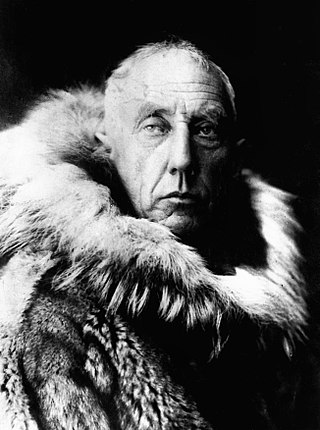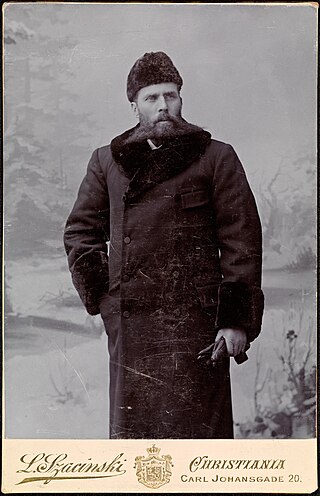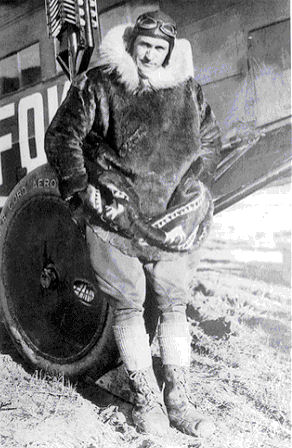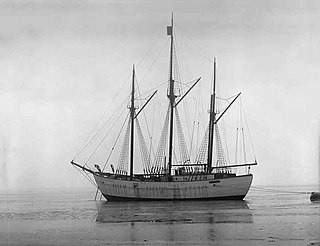
The Northwest Passage (NWP) is the sea route between the Atlantic and Pacific oceans through the Arctic Ocean, along the northern coast of North America via waterways through the Canadian Arctic Archipelago. The eastern route along the Arctic coasts of Norway and Siberia is accordingly called the Northeast Passage (NEP). The various islands of the archipelago are separated from one another and from Mainland Canada by a series of Arctic waterways collectively known as the Northwest Passages, Northwestern Passages or the Canadian Internal Waters.

Roald Engelbregt Gravning Amundsen was a Norwegian explorer of polar regions. He was a key figure of the period known as the Heroic Age of Antarctic Exploration.

Baffin Island, in the Canadian territory of Nunavut, is the largest island in Canada and the fifth-largest island in the world. Its area is 507,451 km2 (195,928 sq mi) with a population density of 0.03/km²; the population was 13,039 according to the 2021 Canadian census; and it is located at 68°N70°W. It also contains the city of Iqaluit, which is the capital of Nunavut.

Sir John Ross was a Scottish Royal Navy officer and polar explorer. He was the uncle of Sir James Clark Ross, who explored the Arctic with him, and later led expeditions to Antarctica.

HMS Resolute was a mid-19th-century barque-rigged ship of the British Royal Navy, specially outfitted for Arctic exploration. Resolute became trapped in the ice and was abandoned in 1854. Recovered by an American whaler, she was returned to Queen Victoria in 1856. Timbers from the ship were later used to construct the Resolute desk which was presented to the President of the United States and is located in the White House Oval Office.

The Chukchi Sea, sometimes referred to as the Chuuk Sea, Chukotsk Sea or the Sea of Chukotsk, is a marginal sea of the Arctic Ocean. It is bounded on the west by the Long Strait, off Wrangel Island, and in the east by Point Barrow, Alaska, beyond which lies the Beaufort Sea. The Bering Strait forms its southernmost limit and connects it to the Bering Sea and the Pacific Ocean. The principal port on the Chukchi Sea is Uelen in Russia. The International Date Line crosses the Chukchi Sea from northwest to southeast. It is displaced eastwards to avoid Wrangel Island as well as the Chukotka Autonomous Okrug on the Russian mainland.

Otto Neumann Knoph Sverdrup was a Norwegian sailor and Arctic explorer.

Gjøa was the first vessel to transit the Northwest Passage. With a crew of six, Roald Amundsen traversed the passage in a three-year journey, finishing in 1906.

Carl Benjamin "Ben" Eielson was an American aviator, bush pilot and explorer. Eielson Air Force Base in Alaska is named in his honor.

Sir George Hubert Wilkins MC & Bar, commonly referred to as Captain Wilkins, was an Australian polar explorer, ornithologist, pilot, soldier, geographer and photographer. He was awarded the Military Cross after he assumed command of a group of American soldiers who had lost their officers during the Battle of the Hindenburg Line, and became the only official Australian photographer from any war to receive a combat medal. He narrowly failed in an attempt to be the first to cross under the North Pole in a submarine, but was able to prove that submarines were capable of operating beneath the polar ice cap, thereby paving the way for future successful missions. The US Navy later took his ashes to the North Pole aboard the submarine USS Skate on 17 March 1959.

Louise Arner Boyd was an American explorer of Greenland and the Arctic, who wrote extensively of her scientific expeditions, and became the first woman to fly over the North Pole in 1955, after privately chartering a DC-4 and crew that included aviation pioneers Thor Solberg and Paul Mlinar.

Maud, named for Queen Maud of Norway, was a ship built for Roald Amundsen for his second expedition to the Arctic. Designed for his intended voyage through the Northeast Passage, the vessel was built in Asker, a suburb of the capital, Oslo.

Farthest North describes the most northerly latitude reached by explorers, before the first successful expedition to the North Pole rendered the expression obsolete. The Arctic polar regions are much more accessible than those of the Antarctic, as continental land masses extend to high latitudes and sea voyages to the regions are relatively short.

The Arctic Ocean is the smallest and shallowest of the world's five major oceans. It spans an area of approximately 14,060,000 km2 (5,430,000 sq mi) and is known as one of the coldest of oceans. The International Hydrographic Organization (IHO) recognizes it as an ocean, although some oceanographers call it the Arctic Mediterranean Sea. It has been also been described as an estuary of the Atlantic Ocean. It is also seen as the northernmost part of the all-encompassing World Ocean.

Capt. George Baker Leavitt Sr. was a Maine-born mariner who captained several whaling vessels out of New Bedford, Massachusetts. The steam whalers captained by Leavitt were active in the whaling fishery off the Alaska North Slope, where Leavitt met and married an Inupiaq woman. The mariner befriended many early Arctic explorers, whom he replenished with supplies and provided transportation to, as well as assisted in Arctic exploration. Leavitt Island in the Beaufort Sea's Harrison Bay is named for the early New England whaling captain.
Thomas Henry Manning, OC was a British-Canadian Arctic explorer, biologist, geographer, zoologist, and author. Appointed an Officer of the Order of Canada, Manning held the positions of vice-chairman and Executive Director of the Arctic Institute of North America. Nicknamed the Lone Wolf of the Arctic, he was known for travelling alone with dog sled and canoe.
Sara Diane Wheeler is an English travel author and biographer, noted for her accounts of polar regions.

Mark Wood FRGS, is a British explorer, professional speaker, expedition leader, and author. He served in the British Army in the Second Battalion, Royal Regiment of Fusiliers, and as a firefighter in the Royal Berkshire Fire and Rescue Service. He subsequently became an explorer, and expedition leader where he has trained and led teams for major Polar and mountain expeditions in extreme environments such as the Arctic Circle, the Himalayas, Antarctica, Alaska, and the Canadian and Norwegian High Arctic to raise awareness of climate change and creates very large virtual classrooms to talk to schools and children about these issues.
Emily Johnson is an American dancer, writer, and choreographer of Yup'ik descent. She grew up in Sterling, Alaska and is based in New York City. She is artistic director of her performance company, Emily Johnson/Catalyst. Johnson is a organizer for the First Nations Dialogues New York/Lenapehoking. She has worked part-time at Birchbark Books, an independent bookstore owned by author Louise Erdrich.















